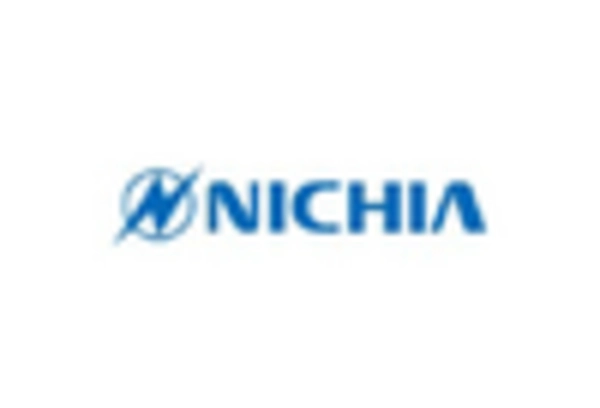Growth in Automotive Sector
The Opto Semiconductor Market is significantly impacted by the growth in the automotive sector, particularly with the rise of electric vehicles (EVs) and advanced driver-assistance systems (ADAS). In 2025, the automotive segment is projected to account for approximately 20% of the total opto semiconductor market, driven by the increasing incorporation of opto semiconductors in vehicle lighting, sensors, and communication systems. The demand for enhanced safety features and energy-efficient solutions in vehicles is likely to further accelerate this trend. Moreover, the integration of opto semiconductors in autonomous driving technologies is expected to create substantial opportunities for innovation and development. As automotive manufacturers continue to prioritize sustainability and technological advancement, the opto semiconductor market is poised for significant growth, highlighting its essential role in the evolving automotive landscape.
Rising Adoption of IoT Devices
The Opto Semiconductor Market is experiencing a surge in growth due to the rising adoption of Internet of Things (IoT) devices. As industries increasingly leverage IoT technologies for automation and data collection, the demand for opto semiconductors is expected to rise correspondingly. In 2025, the market for opto semiconductors in IoT applications is projected to reach around 12 billion USD, reflecting a robust growth rate. Opto semiconductors are integral to various IoT devices, providing essential functionalities such as sensing, communication, and data processing. The proliferation of smart home devices, industrial automation systems, and wearable technology is likely to drive this demand further. As the IoT ecosystem continues to expand, the Opto Semiconductor Market is positioned to benefit significantly from these trends, indicating a promising outlook for manufacturers and stakeholders.
Surge in Consumer Electronics Demand
The Opto Semiconductor Market is experiencing a notable surge in demand driven by the proliferation of consumer electronics. As households increasingly adopt smart devices, the need for efficient opto semiconductors has escalated. In 2025, the market for opto semiconductors in consumer electronics is projected to reach approximately 15 billion USD, reflecting a compound annual growth rate of around 8%. This growth is largely attributed to the integration of opto semiconductors in displays, lighting, and sensing applications. Furthermore, the trend towards miniaturization and enhanced functionality in consumer gadgets necessitates advanced opto semiconductor solutions, thereby propelling the market forward. The ongoing innovation in product design and technology is likely to further stimulate demand, making this sector a pivotal driver in the Opto Semiconductor Market.
Expansion of Renewable Energy Sources
The Opto Semiconductor Market is significantly influenced by the expansion of renewable energy sources. As nations strive to reduce carbon emissions, the adoption of solar energy systems has surged. In 2025, the market for opto semiconductors in solar applications is estimated to exceed 10 billion USD, indicating a robust growth trajectory. Opto semiconductors play a crucial role in photovoltaic systems, enhancing energy conversion efficiency and overall system performance. The increasing installation of solar panels and related technologies is likely to create substantial opportunities for opto semiconductor manufacturers. Additionally, the integration of opto semiconductors in energy management systems is expected to optimize energy usage, further solidifying their importance in the renewable energy sector. This trend underscores the potential for growth within the Opto Semiconductor Market as it aligns with global sustainability goals.
Technological Advancements in Lighting Solutions
The Opto Semiconductor Market is witnessing transformative changes due to technological advancements in lighting solutions. The shift towards LED lighting has revolutionized the market, with LED technology accounting for over 60% of the total lighting market share in 2025. This transition is driven by the superior energy efficiency, longevity, and reduced environmental impact of LED lights compared to traditional lighting solutions. The demand for smart lighting systems, which utilize opto semiconductors for enhanced control and automation, is also on the rise. As urbanization continues to expand, the need for efficient and sustainable lighting solutions is likely to propel the opto semiconductor market further. The integration of opto semiconductors in smart city initiatives and IoT applications is expected to create new avenues for growth, reinforcing their critical role in the Opto Semiconductor Market.















Leave a Comment